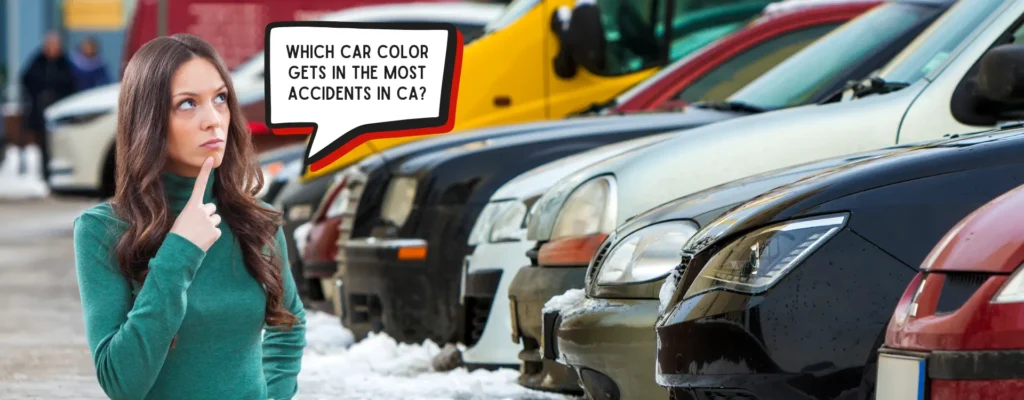
Car color can have a measurable impact on accident rates, as visibility is key to road safety. Studies examining which color car gets in the most accidents reveal that darker shades like black and gray are more frequently involved in collisions. These colors are harder to spot, especially in low-light conditions or bad weather, making it difficult for other drivers to react in time.
In contrast, when reviewing car accidents by color, lighter shades like white and yellow are generally linked to fewer crash incidents. These colors are more visible, standing out more clearly on the road and helping to reduce the risk of accidents. As a result, car color has become an important factor for those looking to improve safety on the road.
IN NEED OF A POST- ACCIDENT CAR REPAIR?
California’s Traffic and Car Color Trends
California’s traffic conditions vary greatly between urban and rural areas. In cities like Los Angeles, heavy congestion and frequent stops increase the likelihood of accidents, especially during rush hour. In contrast, rural roads often have limited lighting, making it difficult for drivers to see other vehicles clearly. These factors are important when considering which car color gets in the most accidents, as visibility is key to safety.
Among the most popular car colors in California are white, gray, and black. White cars tend to be more visible, while darker colors like black and gray can blend into the environment, particularly in low-light conditions such as at dusk or during fog. This reduced visibility may contribute to higher rates of car accidents by color, suggesting that the choice of vehicle color can affect safety on the roads.
Which Car Color Gets In the Most Accidents?
The answer to what car colors are the most dangerous often points to the darkest hues. While owning a black, gray, blue, or green vehicle does not automatically mean a driver is unsafe, these colors are linked to a higher risk of accidents. Darker-colored vehicles tend to have more accidents than lighter ones.
- Black. This is the most dangerous color, with a 12% higher likelihood of being involved in an accident compared to white vehicles. The risk increases during low-light conditions, such as dusk and dawn, where black cars are up to 47% more likely to be involved in accidents because they are difficult to see.
- Gray. Gray cars also present visibility challenges, carrying an 11% higher crash risk than white vehicles. Their muted tones can easily be missed by other drivers, particularly in low-light situations.
- Silver. Slightly lighter than gray, silver cars still carry a 10% increased accident risk and are 15% more likely to be involved in crashes at dawn or dusk.
- Blue. Blue vehicles rank as the fourth most dangerous car color. Many blue cars are darker, and even brighter shades can blend in with the sky. Blue cars are 7% more likely to get into an accident compared to white vehicles.
- Red. Red cars also show a 7% higher accident rate, possibly due to the variety of shades available, which can include darker tones that reduce visibility.
- Green. Green cars often face similar visibility issues, with many options being darker shades. While they tend to have fewer accidents than some other colors, they can be involved in more severe accidents.
What Are the Safest Car Colors?
When exploring car accidents by color, the safest options are typically the lightest and brightest. These popular color choices provide high contrast against their surroundings, improving visibility for drivers. While choosing a white car does not guarantee safety, it does contribute to a lower accident rate.
- White. This is not only the safest color but also one of the most popular choices for vehicles, commonly found in minivans, pickups, and sedans. White cars have a 12% lower accident rate than black vehicles, offering excellent visibility in various driving conditions.
- Yellow. Following closely behind, yellow is a safe color choice as well. Some studies suggest that a yellow car may be safer than white due to its brightness, which stands out against most backgrounds.
- Orange. Orange is a safe option, though it is less common on the road. This bright color provides excellent visibility, making it appealing for sports cars.
- Gold. Although not widely available, gold is considered a safe color option. Its visibility helps it stand out well against various backgrounds, contributing to its safety profile.
Car Color, Insurance, and Crash Risk
The perceived risk of specific car colors can influence policy decisions and coverage options. When a color consistently correlates with higher accident rates, insurers may adjust their underwriting criteria, leading to different terms for vehicles in that color category. This means that drivers who opt for popular but riskier colors may face higher costs and limited options.
Understanding which car color gets in the most accidents is important for consumers when making purchasing decisions. While personal preferences matter, it is equally important to consider the potential impact on both financial costs and driver safety. Making informed decisions based on data on car accidents by color can help mitigate risks, regardless of the selected color of your vehicle.
Should You Consider Changing Your Car Color for Safety?
Collision Connect is California’s top online platform for automotive repair shops, focusing on vehicle safety and repair services. One key consideration is the color of your car, which can directly affect accident rates. Statistics show that certain colors are more prone to collisions due to visibility issues, making it worthwhile to explore the benefits of changing your car color to reduce the risk of being involved in a crash.
We connect you with trusted technicians in California who are well-versed in the relationship between car color and visibility. Consult with our experts today to explore how a simple color change could improve your vehicle’s safety and reduce your risk on the road!
IN NEED OF A POST- ACCIDENT CAR REPAIR?